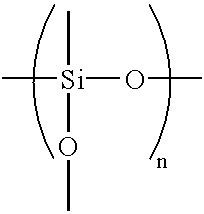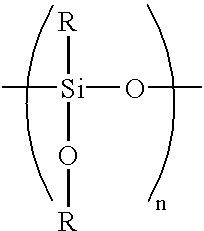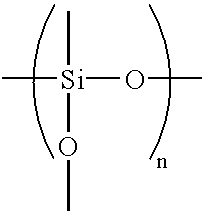Although zinc-based alloy plating can impart high corrosion resistance to steel sheets by alloying nickel or iron with zinc, it has several problems attributable to being alloy plating.
For example, zinc-
nickel alloy plated steel sheets are manufactured by electrogalvanizing and the cost is high because nickel is expensive.
Furthermore, the
nickel content should be normally adjusted in an extremely
narrow range (for example, 12.+-.1
mass %), which makes its manufacture difficult.
However, when zinc-iron-alloy plated steel sheets are manufactured by electrogalvanizing, it entails difficulty in alloy control, i.e. adjusting the
iron content in the zinc plating layer in an extremely
narrow range, similar to zinc-
nickel alloy plated steel sheets.
In addition, Fe.sup.2+ ions in the plating solution are prone to be oxidized, which destabilizes plating and makes the manufacture difficult.
As a result, the cost is high.
However, the quality of plating produced by this method is susceptible to the Al concentration in molten zinc plating baths and to the temperature and duration of the alloying process, and an advanced technology is necessary to manufacture uniform alloy plating
layers.
As a result, the cost is high also in this case.
As mentioned above, zinc-based-alloy plating has problems that any form of them is difficult to manufacture and the cost is high.
However, they are rarely used as automobile bodies.
The reason is that zinc plating alone cannot provide enough corrosion resistance, especially when galvanized steel sheets are exposed to a corrosive environment for a long time, the steel sheets tend to develop perforation by corrosion, which causes a problem in terms of guarantee of the strength of automobile bodies.
Furthermore, galvanized steel sheets have problems that a quantity of zinc tends to deposit on electrodes in
spot welding, which shortens the life of electrodes, and the plates have poor press
formability.
It is said the lower parts of
doors are most likely to develop perforation by corrosion.
The reasons are that steel sheets are folded at the lower parts of
doors, and water entering through slits of windows etc. pools in the folded parts, which accelerates the corrosion compared to the other parts of automobile bodies.
Among the treatments applied after the press forming of bodies, the
chemical conversion treatment and the
electroplating can be applied to the inner surface of
doors, but in the
spray painting, which is conducted afterwards, the paint cannot reach the inner surface.
Therefore, the anti-corrosive effect of the
spray painting cannot be expected to be obtained, and corrosion resistance after the electrodeposition painting is important.
However, although the coated
metal materials which have a
phosphate coating containing only
magnesium as described in the above-mentioned publication are resistant to
rust formation in a salt spray corrosion test, they have insufficient perforative corrosion resistance in a composite cycle corrosion
resistance test, which yields similar results to the actual corrosion in automobile bodies.
These surface-treated steel sheets have sufficient corrosion resistance with insufficient electrodeposition painting, which is applied after
assembly of automobile bodies, and therefore contribute to prolonged lives of automobiles.
Therefore, extremely strict
wastewater treatment is necessary when the steel sheet is used, which increases the cost.
On the other hand, the heavy coated zinc hot-dip galvanized steel sheet in which
chromium is not used has several quality problems, namely, it has poor press formability, and it tends to develop craters during electrodeposition painting and has poor electrodeposition paintability.
Furthermore, the heavy coated electrogalvanized steel sheet has poor press formability similar to the thick-coated zinc hot-dip galvanized steel sheet and is too expensive in Japan, where the
electricity costs are high.
On the other hand, when a steel sheet has no chromate layer, the plating layer needs to be thick, which makes the steel sheet inferior in press formability and electrodeposition paintability.
However, no consideration for use as automobile bodies, especially for the recent stringent requirement for corrosion resistance, is given to the coated steel sheets described in the above-mentioned
patent application publications.
Namely, because the coating weight of zinc is low, sacrificial
corrosion prevention by zinc toward iron cannot be exerted for a long time even when the sealing treatment with a
silane coupling agent is conducted.
Therefore these steel sheets develop corrosion of iron at an early stage, and have poor perforative corrosion resistance.
In addition, there is a
disadvantage in that perforative corrosion resistance cannot be ensured in parts where electrodeposition painting is not sufficiently applied after
assembly of automobile bodies.
Therefore, it does not provide a material intended to be subject to blanking, press forming, a chemical conversion treatment, and subsequent various treatments as a material normally used for automobiles.
Furthermore, this
patent application publication shows corrosion resistance after painting but does not evaluate corrosion resistance in parts without sufficient electrodeposition painting, i.e. perforative corrosion resistance with no paint.
Nevertheless, it is difficult for this technology to provide a material intended to be subjected to steps in automobile manufacturers including blanking, press forming, a chemical conversion treatment, and various subsequent treatments as a material normally used for automobiles.
However, the resin cannot follow the transformation of the material in forming and, on the contrary, restrains the transformation of the material, which makes the material prone to crack.
Therefore, the technology has a
disadvantage that satisfactory press formability cannot be obtained.
 Login to View More
Login to View More 


